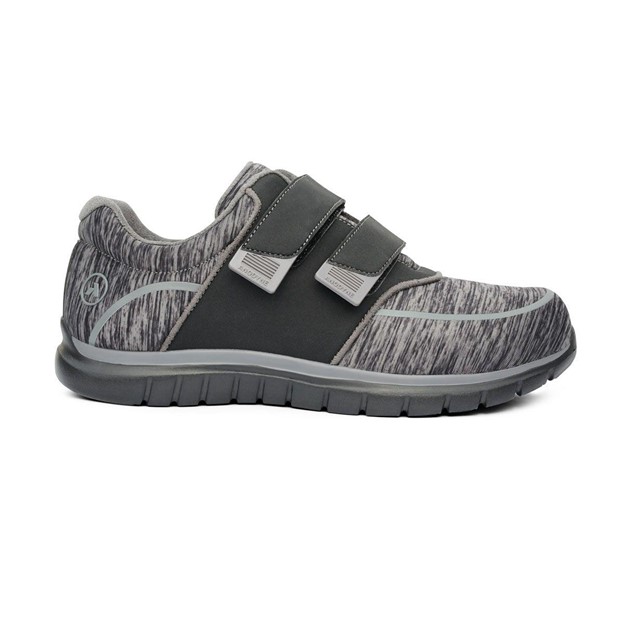If there were two shoes in front of you, would you be able to tell the diabetic shoe apart from the regular one?
In fact, what makes a diabetic shoe… “diabetic”?
We’ll dive into what sets a diabetic shoe apart from its typical counterparts. Aside from gaining a new appreciation for diabetic-specific footwear, we’ll help you understand just exactly what designs and functions of a shoe make it most suitable for diabetic feet.
So, what are the basic differences between normal and diabetic footwear?
Diabetic footwear is made to accommodate problems experienced by those suffering from diabetes. Particular problems include diabetic neuropathy, poor circulation, and skin breakdown. All these conditions produce pain, numbness or tingling sensations, and wounds to the foot area resulting in compromised lower limbs. Unmanaged foot conditions can result in the spread of disease, worsening conditions, and even amputation of the feet.
What are the special features of diabetic footwear?
There are special features of diabetic footwear that make them applicable and beneficial to diabetics.
1. A comfortable cushioned interior to house damage-prone feet
Those with diabetes are at higher risk for damage to their feet from conditions like diabetic neuropathy. A cushioned interior is essential for the protection of diabetic feet and the wounds and damage that can be produced from extensive use and especially falls. This level of protection and cushioning is not seen in regular shoes.
2. Accommodating Interior That Reduces Pressure
Beyond comfort, the interior of a diabetic shoe needs a nonrestrictive environment to prevent diabetic-prone skin conditions like ulcers and bunions. These conditions arise from the skin being too constricted or not having breathing room as seen in normal shoes. Pressure is further reduced to the foot in diabetic shoes with a design that encompasses enough space to fit common orthotic insoles that further relieve pressure and provide support beyond the included insole. Lastly, diabetic shoes incorporate deeper than average toe room to avoid introducing too much weight on these compromised limbs and also to accommodate for the reduced room when used in conjunction with orthotic insoles.
In those with increased concern for pressure, the upper parts of diabetic shoes are made to stretch. Allowing for more wiggle room and less pressure points, diabetic shoes remove the damage associated with constrained feet. Orthotic sandals are also a great option to reduce pressure on the feet.
3. Special insoles that facilitate mobility and provide support.
Normal shoes offer enough support for the average person. Diabetic orthotic insoles provide additional cushioning and support in special areas such as the arch or heel. Diabetics often experience discomfort in these specific areas, so the insole of a diabetic shoe takes the arch and heel into special consideration. The insole further helps facilitate mobility by taking pressure off the foot to promote optimal comfort and function.
The No 77 Double Depth Sports Walker is an orthotic friendly shoe offered with all of the above characteristics in mind. Unique to typical shoe wear, this orthotic shoe offers a wide spacious design perfect for alleviating pressure. The wide design of the No. 77 Double Depth Sports Walker also makes it ideal for additional orthotic insoles.
Enquire here about the No 77 Double Depth Sports Walker.
Because diabetic shoes are made specifically for diabetics, it seems obvious that they would be chosen over the typical shoe. Each of the features of a diabetic shoe works to supply unique, unmatched levels of comfort and relief to the foot area. Here’s how:
- Better stability and control of the foot
- Enhanced circulation
- Protected feet reduce skin breakdown
- Protected feet reduce callouses/ bunions
- Reduce damage to the foot from pressure-induced accidents
Although the mentioned benefits might be enough for most diabetics, some might still contemplate getting a normal old pair of shoes. Misunderstanding of diabetic shoe application, confusion about shopping options and lack of foot health education can all lead to improper shoe wear for diabetic feet. Because the feet of diabetics are so easily compromised, foot safety should be prioritised with the help of a diabetic, problem-focused shoe. Reducing the risk of pain, problems and further damage is a focus normal shoes do not have.
Where Can I Find the Best Shoes for My Diabetic Feet?
Now that you’re better educated on the importance of diabetic shoes, finding the best pair is only a few clicks away.
Suncoast Podiatry proudly offers diabetic footwear to meet all your diabetic concerns. We have orthotic friendly shoes designed by the best foot doctors and perfectly suited for your plantar fasciitis. If damage to your susceptible feet is your concern, we also provide orthotic shoes that provide comfort and safety. Orthotic sandals are highly recommended in hot weather so as not to compromise fashion with function. Orthotic insoles can be used in addition to normal shoe wear as a temporary relief until orthotic shoes can be obtained.
Your feet are precious and under a lot of constant pressure. Take care of them now, so you won’t have to try ten times harder in the future! Take a look at our wide array of footwear, diabetic-specific and accommodating by visiting one of our numerous clinics on the Sunshine Coast. Find the nearest store.

